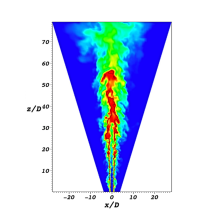Turbulent combustion is an important concept for thermal energy conversion. In turbulent flames chemistry and turbulence strongly interact, which leads to an increased combustion efficiency due to fast mixing, but may also negatively affect flame stability and pollutant formation. For accurate predictions of such turbulence-chemistry interactions and their impact on the environment detailed modelling approaches are required. We use a coupled large eddy simulation (LES) - conditional moment closures (CMC) approach. LES is an accurate method for turbulence modelling and increasingly applied to reacting flows. CMC is a conserved scalar approach where the fluctuations of the reacting scalars are associated with the mixture fraction. LES-CMC in its standard non-conservative formulation has been successfully used to predict turbulent flames for more than a decade. However, deficiencies of non-conservative LES-CMC are apparent, particularly in CMC cells with large temporal variations of the mixture fraction. Here, we use a conservative formulation of LES-CMC, where the convective term is weighted by the filtered density function (FDF) ratio to improve the predictive capabilities. The conservative LES-CMC approach is validated against well-defined experimental data from the non-premixed Sandia piloted jet flame series, which covers a significant range of turbulence-chemistry interactions.
Movie 1
Movie 1: Large eddy simulation of the piloted non-premixed methane jet flame Sandia Flame D using a conditional moment closure (CMC) approach for flame chemistry and turbulence chemistry interaction. The animation shows the gas density field, with a low density in the hot pilot stream and the flame, and a higher density in the central jet (25%/75% CH4/air) and coflow (pure air).
Related publications
- A. Kronenburg and O. T. Stein, “LES-CMC of a Partially Premixed, Turbulent Dimethyl Ether Jet Diffusion Flame,” Flow, Turbul. Combust., vol. 98, pp. 803–816, (2017).
- P. Siwaborworn and A. Kronenburg, “Conservative Implementation of LES-CMC for Turbulent Jet Flames,” in High Performance Computing in Science and Engineering ’12, (2013), pp. 159–173.
- A. Kronenburg and E. Mastorakos, “The Conditional Moment Closure Model,” in Turbulent Combustion Modeling: Advances, New Trends and Perspectives, T. Echekki and E. Mastorakos, Eds. Dordrecht: Springer Netherlands, (2011), pp. 91--117.
Contact

Andreas Kronenburg
Univ.-Prof. Dr.Director of the Institute


